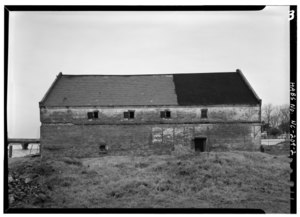Battle of Washington
| Battle of Washington, North Carolina | |||||||
|---|---|---|---|---|---|---|---|
| Part of the American Civil War | |||||||
 Union forces attempted to set fire to Havens Warehouse (above) but it survived the war. |
|||||||
|
|||||||
| Belligerents | |||||||
|
|
|
||||||
| Commanders and leaders | |||||||
| John G. Foster | Daniel H. Hill | ||||||
| Units involved | |||||||
|
XVIII Corps Washington Garrison |
Hill's Division | ||||||
| Strength | |||||||
| 6 regiments artillery units |
1 Division | ||||||
| Casualties and losses | |||||||
| 40 | 60 | ||||||
The Battle of Washington took place from March 30 to April 19, 1863, in Beaufort County, North Carolina, as part of Confederate Lt. Gen. James Longstreet's Tidewater operations during the American Civil War. This battle is sometimes referred to as the Siege of Little Washington.
After the culmination of Burnside's North Carolina Expedition little attention had been given to North Carolina by the Confederate Army. In December 1862 a Union expedition from New Berne destroyed the railroad bridge at Goldsboro, N.C. along the vital Wilmington and Weldon Railroad. This expedition caused only temporary damage to the railroad, but did prompt Confederate authorities to devote more attention to the situation along the coast of Virginia and North Carolina.
Following the Confederate victory at Fredericksburg, General Robert E. Lee felt confident enough to dispatch a large portion of his army to deal with Union occupation forces along the coast. The whole force was put under the command of Lt. Gen. James Longstreet. While Longstreet personally operated against Suffolk, Maj. Gen. D. H. Hill led a column which moved against Federal garrisons at New Berne and Washington, North Carolina.
Maj. Gen. John G. Foster, commanding the Department of North Carolina, was responsible for the overall defense of the Union garrisons along the North Carolina coast. After Hill's attack against New Berne failed, Foster arrived in Washington to take personal command of the garrison.
...
Wikipedia
